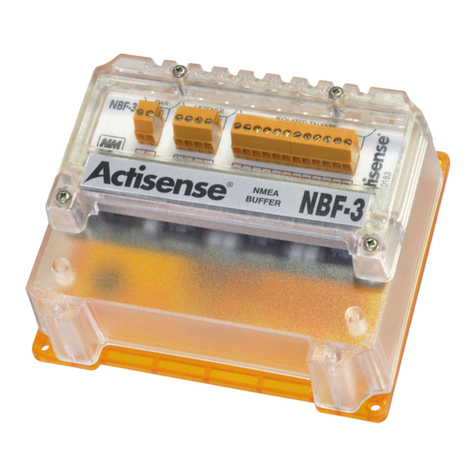
NMEA 2000 Engine Monitoring Unit - EMU-1
Page 19© 2015 Active Research LimitedPage 18© 2015 Active Research Limited
Specications
Table 4 - Specication Table
Table 3 - NMEA 2000 PGN List
PGN PGN Name Rx Tx Data Tx Rate
59392 ISO Acknowledge YES YES
59904 ISO Request YES NO
60160 ISO Transport Protocol, Data Transfer YES YES
60416 ISO Transport Protocol, Connection Management YES YES
60928 ISO Address Claim YES YES
65240 ISO Commanded Address YES NO
126208 NMEA Request/Command/Acknowledgement YES YES
126464 Rx & Tx PGN Lists NO YES
126720 Proprietary Fast-Packet YES YES
126996 Product Information NO YES
126998 Conguration Information NO YES
127488 Engine Parameters, Rapid Update NO YES 0.1 seconds
127489 Engine Parameters, Dynamic NO YES 0.5 seconds
127493 Transmission Parameters, Dynamic * NO YES 0.5 seconds
127505 Fluid Level * NO YES 2.5 seconds
127508 Battery Status NO YES 1.5 seconds
* Not enabled by default / Enabled by EMU Cong Tool
Supported NMEA 2000 PGNs
118.0
127.0
105.5
96.5
3.5
47.5
All measurements in mm
112.0
Dimension Diagram
Power Supply
Supply Voltage 9 to 35V DC
Supply Current Typically < 25mA @ 12V DC
Supply Protection
Continuous reverse polarity
protection and load dump
protection (meets SAE J1113)
Supply Connector Pluggable 2-way screw terminal,
3.5mm pitch
Supply Voltage
(NMEA 2000 port) 9 to 29V DC
Supply Current
(NMEA 2000 Port)
< 20mA @ 12V DC from NMEA
2000 bus
Load Equivalence Number
(NMEA 2000 Port) 1 LEN
Supply Protection
(NMEA 2000 Port)
Continuous reverse polarity
protection and overvoltage
protection to 40V
NMEA 2000 Port - In/Out
Compatibility NMEA 2000 compatible
Galvanic Isolation 2500V input to ground
Speed / Baud Rate 250kbps
NMEA 2000 connector M12 male (A coded) connector
Gauge Inputs
Voltage Range 0 to 35V DC
Input Impedance > 50kΩ
Sender Feed 0, 4 or 18mA
Accuracy <= 2%
Input Connector Pluggable 6-way screw terminal,
3.5mm pitch
Input Protection Overvoltage protection to ±40V
Alarm Inputs
Voltage Range 0 to 37V DC
Input Impedance > 50kΩ
Threshold Voltage Congurable, default is 5V
Alarm Polarity Congurable, default is alarm on
low input
Accuracy <= 2%
Input Connector Pluggable 4-way screw terminal,
3.5mm pitch
Input Protection Overvoltage protection to ±40V
Tacho Inputs
Voltage Range ±3 to ±60V
Input Impedance > 100kΩ to ground
Input Pulse Range 4 to 50,000Hz
Accuracy <= 1%
Sender Compatibility
Ignition coil, alternator (“W”, “R” or
“AC”) terminal, hall effect, VR or
inductive sender
Threshold Automatically adjusts to signal
level
Input Connector Pluggable 4-way screw terminal,
3.5mm pitch
Input Protection Can withstand an ignition pulse to
±500V
Engine Log
Engine Hours
2 separate engine hour logs
internally connected to the tacho
Inputs. Hours are logged when
RPM is present, stored in non-
volatile memory
Mechanical
Housing Material Polycarbonate
Protective Lid Material Polycarbonate
Sealing Materials
Expanded silicone foam gasket,
closed cell polyurethane splash
guard and ePTFE waterproof vent
Dimensions 127mm (L) x 112mm (W)
x 48mm (H)
Weight 250g
Mounting
4 x 3.5mm lugs to allow panel
mount with self tapping s/s screws
(included), optional DIN Rail
mount available on request
Approvals and Certications
Fully NMEA 2000 Certied
EMC EN 60945 (sections 9 & 10)
Environmental Protection IP66 (PCB housing)
Operating Temperature -20°C to +55°C
Storage Temperature -30°C to +70°C
Relative Humidity 0 to 93% RH
Guarantee 3 years
Figure 14 - Dimension Diagram
All specications are taken with reference to an ambient temperature (TA) of +25°C.




























